We may receive a commission when you use our affiliate links. However, this does not impact our recommendations.
 Old chisels can be brought back to life using these simple steps.
Old chisels can be brought back to life using these simple steps.
If ever there was a type of used hand tool that was a good candidate for restoration, it’s a chisel. Lots of good deals on old chisels can be found at flea markets, garage sales and auctions. And while many old tools – such as kinked hand saws or badly warped planes – may be hopelessly damaged, it’s usually not hard to bring a chisel back to a working life.
The process of restoring a chisel back into working order involves four basic steps:
1) Flattening and polishing the back
2) Grinding the edge square to the sides
3) Grinding the bevel
4) Honing the bevel
These steps ensure that the cutting edge will consist of two polished intersecting surfaces, which is the essence of any sharp, durable edge. And a flat back is important because it serves as a directional reference in many paring and chopping operations.
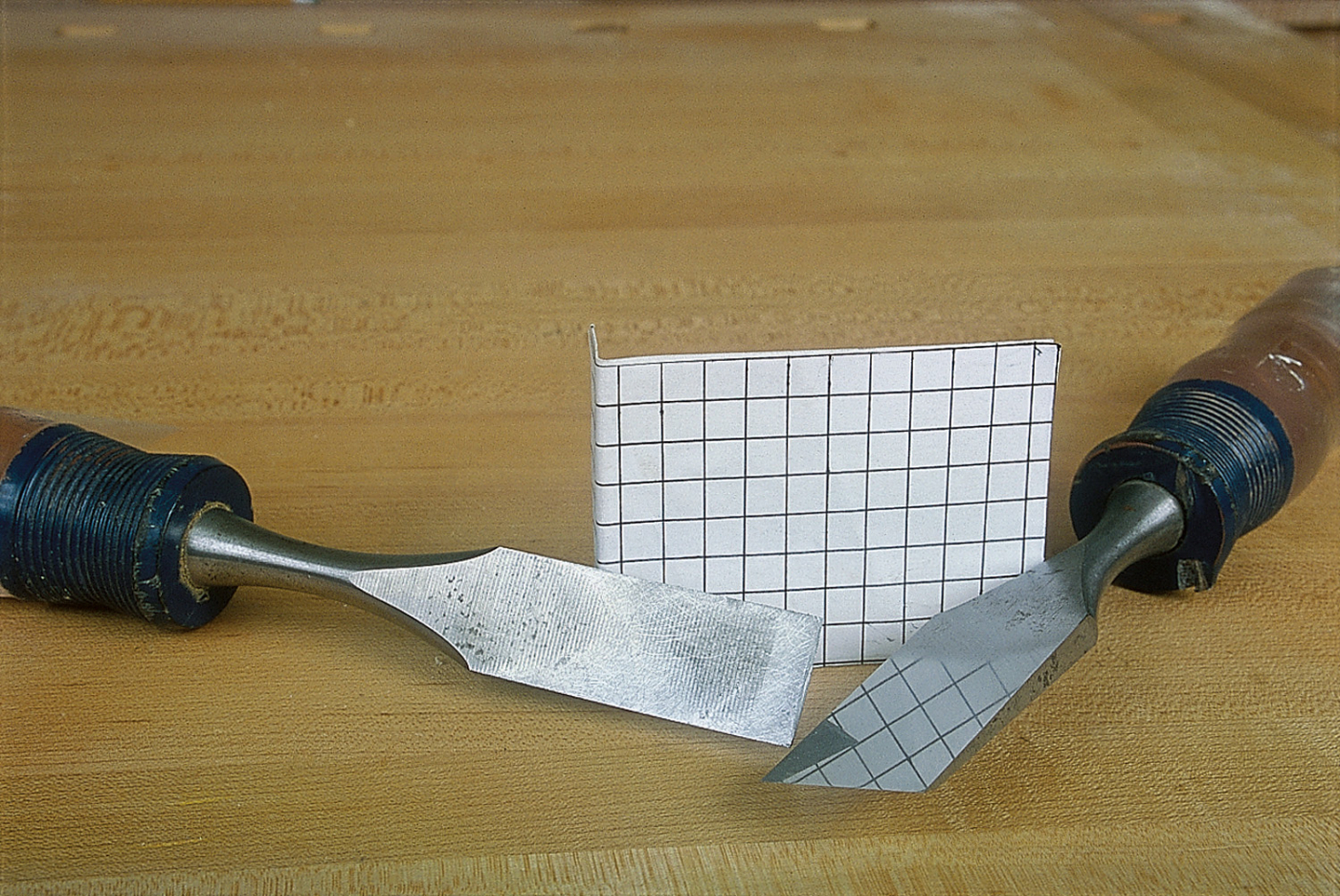
With chisels, it’s not hard to turn junk into a jewel. It took less than an hour to convert an abused tool like the one on the left side of each picture into a stunningly sharp specimen like the one at right.
 In this article, I will take you through these processes step by step, including the nuances that can make all the difference in getting a frighteningly keen edge. Although the following approach – arrived at after years of teaching sharpening and testing products – is certainly not the only way to sharpen, I think you’ll find that it yields great results. For most chisels, it’s the blade that needs work, not the handle. Most wooden handles can be sanded and refinished. If you need to replace yours, I recommend you read “Making Your Own Chisel Handles” from the February 2002 issue.
In this article, I will take you through these processes step by step, including the nuances that can make all the difference in getting a frighteningly keen edge. Although the following approach – arrived at after years of teaching sharpening and testing products – is certainly not the only way to sharpen, I think you’ll find that it yields great results. For most chisels, it’s the blade that needs work, not the handle. Most wooden handles can be sanded and refinished. If you need to replace yours, I recommend you read “Making Your Own Chisel Handles” from the February 2002 issue.
A Sharpener’s Best Teachers
Sharpening is a tiny art. It’s impossible for the naked eye to detect progress on the scale that really matters. For that you’ll need two very important helpers: light and magnification. To best learn sharpening, inspect your work closely after every step, viewing it under a strong light with an 8x or 10x magnifying loupe. (An inexpensive loupe works fine.) You’ll be amazed what your naked eye doesn’t see. And if a cutting edge looks good under strong magnification, you can bet it will cut well.
Working with Waterstones
Years ago, I was sharpening with oilstones, like everyone else I knew. But after Japanese waterstones hit the market, a friend brought his over for me to try, and I was sold in about three minutes. Unlike oilstones, waterstones cut quickly because the surface particles on these soft-bond stones break free in use, exposing new, sharp particles for continued aggressive cutting. However, the cost of this is that the stones must be dressed, or flattened, frequently during use because dips or humps in the surface would compromise the flatness or straightness of the tool being sharpened. You can easily dress a stone by rubbing it on #220-grit silicon carbide paper glued to a sheet of plate glass with spray adhesive. A more convenient, but expensive, alternative is to use a coarse diamond plate like I do.

Dress a waterstone flat by rubbing it on a diamond plate or sheet of #220-grit silicon carbide paper on glass until the entire face of the stone is clean. The small dark area of metal particles near the end of this stone shows that it needs just a bit more dressing.
Waterstones are available in a variety of grits: typically #220, #800, #1,000, #1,200, #4,000, #6,000 and #8,000. Grits #4,000 and up are considered finish stones, which impart the final polish to the metal. Expect to pay about $20 per stone except for #6,000- and #8,000-grit stones, which can cost twice as much. For restoring a blade, I use grits #220, #800, #1,200 and #8,000.
If you’re on a budget, I recommend as a starter set a Norton #220-grit stone (discussed in a moment), an #800-grit stone and a #4,000-grit stone. The last stone will give you a perfectly serviceable edge, although not what you could expect from an #8,000-grit stone. Combination stones are also available at a discount, with one grit per side.
With the exception of the finish stones, all waterstones should be submerged in water for 10 minutes prior to use. I leave mine in a constant bath except in a freezing shop. To secure a stone during use, I place it on a thin, rubber, non-skid mat, which works better than any other stone holder I’ve tried in my career.
Tending to the Back
The first step – flattening the back – often requires removing a fair amount of metal. Performed by rubbing the chisel against a stone, this step is also necessary on new chisels to remove the manufacturer’s grinding marks. For this, you really need an aggressive cutting method that doesn’t distort the flatness of the back. After trying everything from coarse silicon carbide paper and diamond stones to ceramic stones and silicon carbide waterstones, by far the best product I’ve discovered for the job is the #220-grit waterstone made by Norton. This $40 soft-bond stone wears down faster than any other stone I’ve used and requires frequent dressing, but the labor saved is well worth the cost of buying a new stone occasionally.
So begin flattening the back on the #220-grit stone. Apply strong pressure with your fingers spread out across the endmost 1-1⁄2” or so of the chisel. Be careful not to lift up or you’ll round over the area near the cutting edge. To help prevent lifting, keep your hands away from the handle. It also helps your leverage if your work surface is just about wrist height.

When flattening the back, orient a chisel diagonally to the stone, then aggressively rub the full length of the stone, moving slightly to the left or right after every few strokes to avoid creating a furrow in the chisel, especially from the edge of a coarse #220-grit stone like this.
It’s very important to rub the tool over the entire surface, turning the stone end-for-end occasionally in order to work both edges.The purpose is to avoid creating a hollow in the stone that will distort the back of the chisel. As a slurry of dislodged stone particles develops, check the chisel for a consistent scratch pattern that will indicate you’re done with this grit. For the most aggressive cutting, wash the slurry from the stone, making sure to re-dress the surface if necessary to flatten it.
Once you’ve created a consistent scratch pattern across the endmost 1-1⁄2” or so of the chisel, continue to rub it for a bit on the slurry, which serves as an intermediate grit between the #220-stone and the next finer grit you’ll use. Wipe the metal clean and dry, then scrutinize it under strong light and magnification to make sure the surface is worked evenly, with no neglected areas or deep individual scratches. Don’t worry if the back is rounded along the cutting edge from previous abuse; you can grind that away later.
Next, with a freshly dressed #800-grit waterstone, maneuver the chisel aggressively in the same fashion, again working the entire surface of the stone. After a slurry builds up, wipe the chisel dry and then check for a consistent scratch pattern under bright light and magnification. You may be able to correct a neglected area with further work on the #800-grit waterstone, but it may be more efficient to reprise your work on the #220-grit waterstone. To make any waterstone cut more aggressively, wash off the slurry or spritz some more water on it. Make sure to re-dress the stone whenever necessary to flatten it.
When you’re done on the #800-grit stone, repeat the processes on a freshly dressed #1,200-grit stone. With this stone, you really want to finish up by working the metal aggressively into the finer-grit slurry because next you jump up to a considerably finer grit on your finish stone. When you’re done with the #1,200-grit stone, the back should show the beginnings of a polish. Now you’re ready for the final polishing on the finish stone.

Rub the back aggressively on the #1,200-grit stone, letting the gray slurry of metal and stone particles build up. The slurry serves as a finer grit that will begin to polish the back, as seen in the inset.

Spritz your freshly dressed finish stone with water and press hard as you rub the back, keeping it flat on the stone. A gray/black slurry of stone and metal particles will begin to build up immediately on the stone as the chisel back starts to show a polish. When friction starts to prevent rubbing, spritz the stone with water. If you need to clean and dress the stone for more aggressive cutting, spray it clean rather than dipping it into your stone bath, where it can become contaminated with coarse particles from the other stones.

After aggressive rubbing on the #8,000-grit stone, the chisel back should be flat and have a near-mirror polish. The angle of reflection shown here shows virtually no scratches, but you would see a very light scratch pattern if you were looking straight at it.
The stone really starts blackening up quickly as the metal starts to shine. The back should now have a very fine scratch pattern with a near-mirror polish. Stop when it won’t polish up any more. You should never have to go through this entire process again because you should only ever touch the back to your finish stone during future resharpenings.
To Jig or Not to Jig
Honing jigs will hold a chisel at a steady angle when honing the bevel. Although there is no dispute that these jigs work, there is some disagreement about the wisdom of depending on them. Those in favor argue correctly that a jig will prevent you from rounding over a bevel if you have trouble maintaining the honing angle freehand. On the other hand, there is no denying that the honing process goes quicker if you don’t have to mount and adjust your tool in the jig before honing. Of course, in the latter case, you do have to invest the time into learning to hone freehand, which I recommend and describe here. But if you prefer to use a honing jig, that’s perfectly fine. I don’t argue religion, politics or sharpening.

A diamond-faced dresser, such as the one shown here, cleans and trues the face of wheel for quick, accurate grinding.
Get Straight and Square
The next step is to grind the edge straight and square to the chisel sides, while removing any nicks or a badly rounded section at the cutting edge. As for grinding equipment, you can use a typical high-speed (3,450 rpm) grinder with a gray wheel, although you risk burning the steel unless you use a well-dressed wheel and a very light touch. A much safer bet is to use a “half-speed” (1,700-1,800 rpm) grinder with an #80- or #100-grit aluminum oxide wheel. Like waterstones, the particles on these soft-bond wheels break away in use, exposing fresh, sharp particles for quicker, cooler cutting. Before grinding, dress your wheel if necessary to clean and true it to remove any gullies or lodged metal particles. You’ll also need a solid, adjustable grinder rest, which you can buy as an aftermarket accessory because most stock grinder rests are nearly useless for accurate sharpening.

Grind the edge straight and square to the chisel sides using light pressure and moving side to side as you cut. Check your progress occasionally with a small machinist’s square.
Set the grinder rest at about 90° to the face of the wheel, then very slowly press the blade against the wheel, moving it side to side as you grind. Check your progress occasionally with a machinist’s square. Don’t apply so much pressure that you risk burning the steel. As long as the wheel is throwing sparks, it’s cutting. If the metal turns blue, it won’t hold an edge in that spot because you’ve ruined its temper.
Grinding the Bevel
To grind the bevel, many sharpeners adjust the rest to the appropriate angle, then lay the chisel on it for grinding. I don’t like this approach because the friction of so much metal on metal prevents the easy side-to-side grinding motion that is so critical to creating a consistent, evenly ground bevel.
Instead, I lay the tang of the chisel against the front edge of the rest, guessing as best I can where the bevel should contact the wheel to grind an angle of about 25°. I then pinch the tang between my thumb and index finger, with the second section of the finger against the edge of the rest to serve as a fence. This reduces metal-to-metal friction to a single point on the edge of the rest and allows very easy side-to-side movement.
Maintaining that grip, I turn on the grinder and lay the bevel against the wheel, sliding the chisel side to side without leaning it left or right. When I have created a facet about 1⁄8” wide, I check the bevel angle using a brass angle checker disk sold for the purpose. If I need to readjust the bevel angle, I slide my grip up or down the tang as necessary to change the lean of the chisel against the wheel. Then I take a few more swipes across the wheel before checking the angle again.
If it becomes hard to identify the most recent facet on a bevel full of facets, wipe the bevel with a wide felt marker, then try again. Once you have established an angle of approximately 25°, lock your grip and don’t move it until you’re finished grinding the bevel.
A finger placed lightly on the back of the chisel helps control downward pressure and serves as a good heat sensor. When the metal gets uncomfortably warm, let it cool to avoid destroying its temper. I avoid quenching it in water when the blunted edge is less than about 1⁄64” wide because quenching can cause minute cracks in a thin cutting edge.
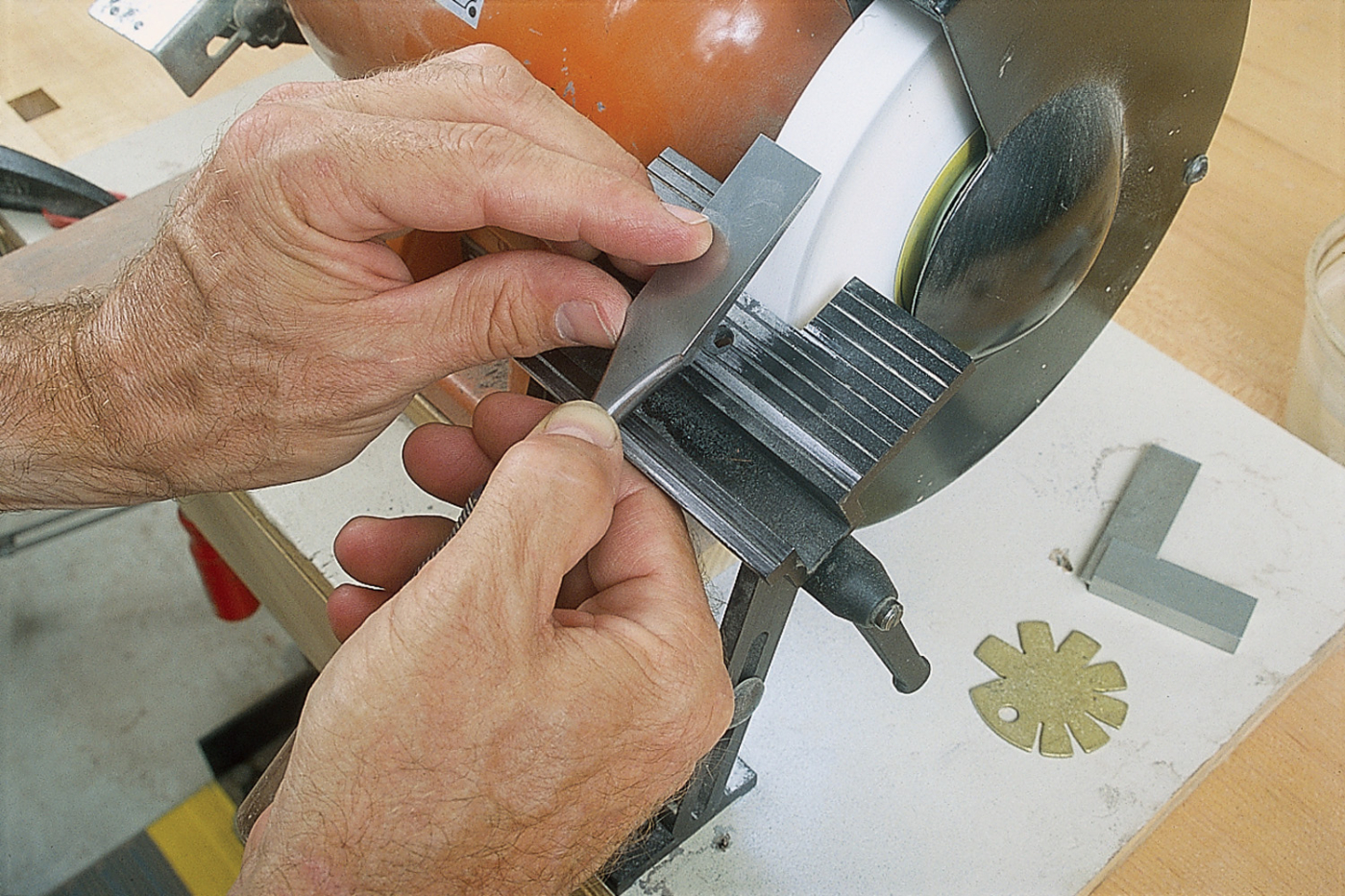
When grinding the bevel, pinch the chisel firmly, using the second section of your index finger as a fence against the rest. A finger placed lightly on the back of the blade helps direct the grinding pressure against the wheel.
As you grind (which may take 15-20 minutes when removing a lot of metal), the most important area to monitor is the very end of the chisel. Make sure the blunt area narrows consistently in order to ensure an evenly ground bevel. This may take some practice, but it’s well worth the effort because a neatly ground bevel makes the subsequent honing a lot easier. Keep grinding until the once blunt area is just a hair’s width.
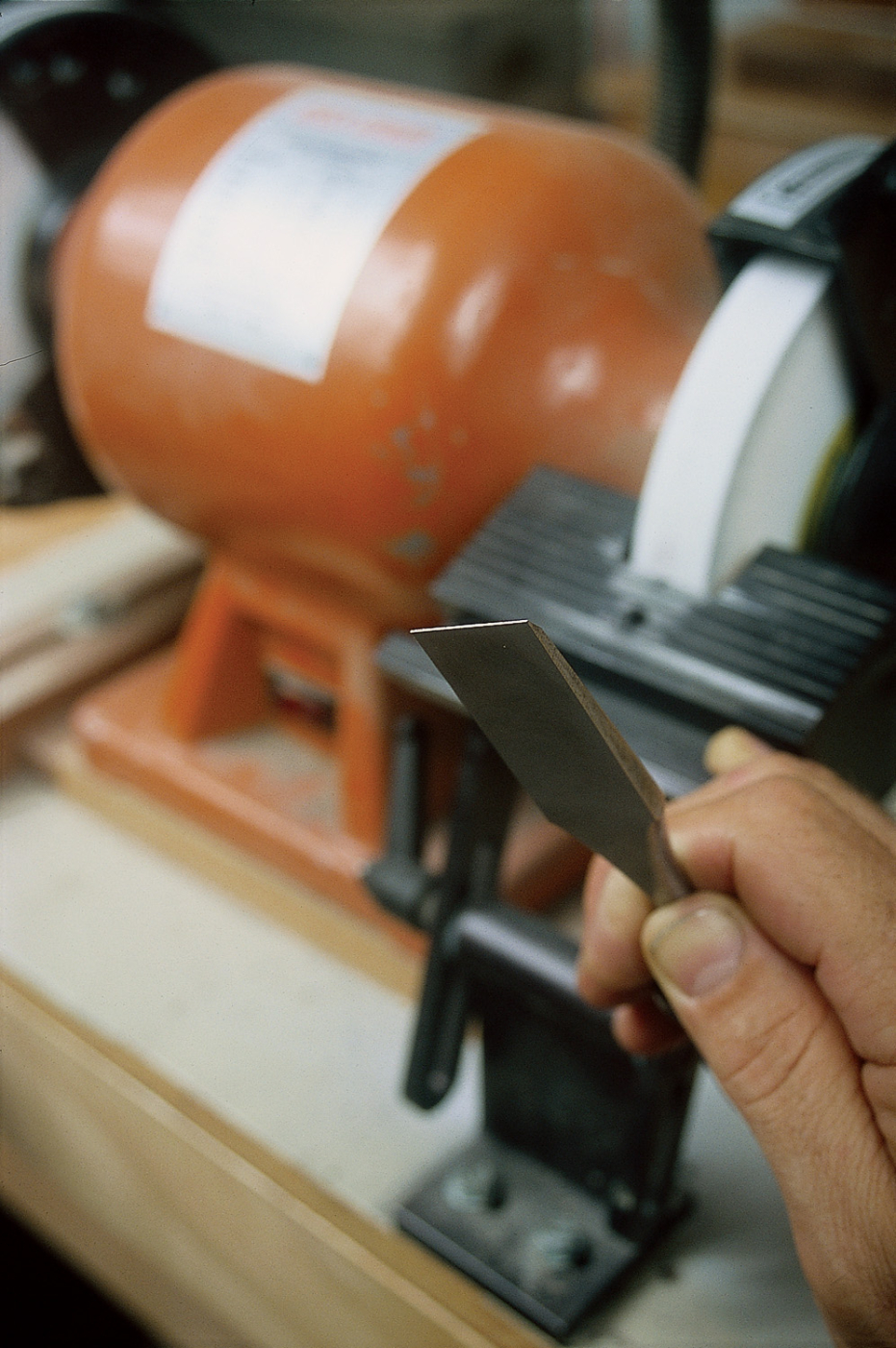
Proper grinding technique results in the blunted end of the blade gradually and consistently narrowing in width until it’s gone. Remember to maintain the same grip throughout the process.
Honing the Bevel
Begin honing the bevel using a freshly dressed #1,200-grit stone. Place the bevel down on the farthest end of the stone because you’ll first pull it toward you. With the sides of the chisel pinched between the fingers of your dominant hand, and the chisel oriented at about 45° to the length of the stone, apply strong downward force behind the bevel with the index finger of your opposite hand. Make sure the toe and the heel of the bevel make firm contact against the stone. The other fingers of your dominant hand should curl under the blade and tang to simply hold the chisel at the proper angle, applying only enough lift to keep it from falling. The farther forward you keep your hands and the more downward pressure you apply at the bevel, the more you’ll prevent the tool from rocking and rounding over the bevel in the process.
Now, with your wrists locked, pull the chisel toward you, maintaining firm pressure over the bevel. Afterward, hop the chisel back to the far end of the stone, and repeat once or twice. These initial pull strokes smooth out the grinding scratches at the very edge, making your upcoming pushes of the chisel much easier and reducing the chance of friction-induced rocking during pushing. After these first few strokes, you should now be able to hone easily with back-and-forth stokes the full length of the stone for efficiency. Remember to keep the cutting edge of the chisel oriented diagonally to the stone to help prevent rocking.
As soon as the newly honed facet runs all the way across the cutting edge, you’re done with the #1,200-grit stone. At this point, take some time to check your progress under magnification. Then spritz water on a freshly dressed finish stone, and work the bevel on it in a similar manner until the facet is evenly polished.
The final quick task is to remove any fine wire edge created in the sharpening process. To do this, lay the chisel on its back at the far end of the stone, then pull it toward you applying a lot of downward pressure at the bevel. This initial pull stroke, instead of a push stroke, prevents trapping a wire edge under the chisel. Work the chisel back and forth three or four times, then flip it onto the bevel again for a few strokes. Finish with a few final strokes on the back and you’re done.
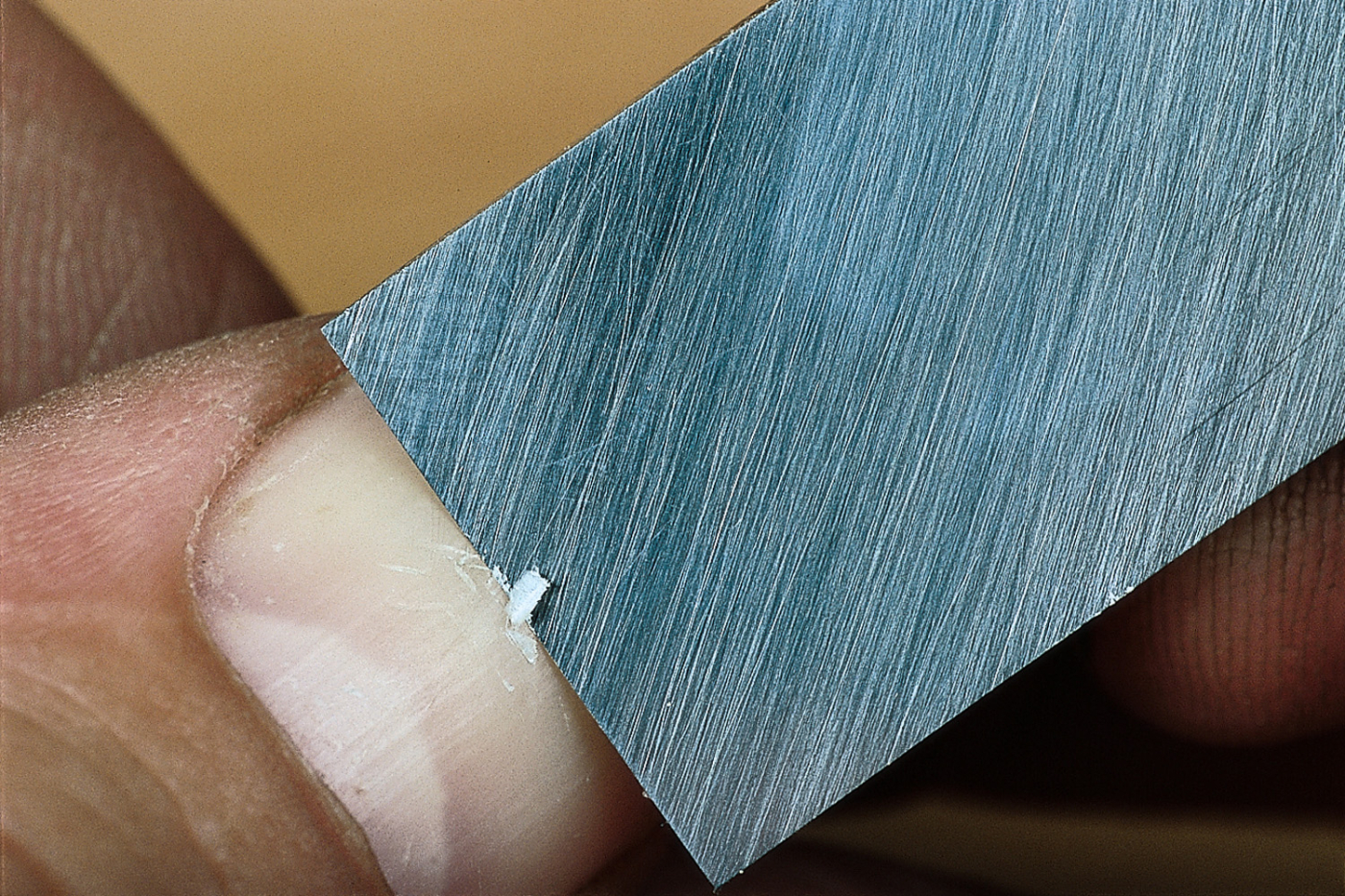
If a blade is truly sharp, it will take a light shaving from your thumbnail. This magnified shot, which shows the #8,000-grit scratch pattern, is the same polish seen on the restored chisel in the photos at the top of this article, but viewed from straight on.
If you’ve done your job well, at this point you should be able to shave your arm hair or pare just a whisper of a shaving from your thumbnail, as shown above. You can also welcome a new member to your family of tools.
Bonus: Honing freehand
 Front view: The secret to successful freehand honing is to concentrate all of your attention at the business end of the chisel, applying strong downward pressure above the bevel with your left hand. Use your right hand to power the chisel, pinching its sides between your index finger and thumb, as shown here.
Front view: The secret to successful freehand honing is to concentrate all of your attention at the business end of the chisel, applying strong downward pressure above the bevel with your left hand. Use your right hand to power the chisel, pinching its sides between your index finger and thumb, as shown here.
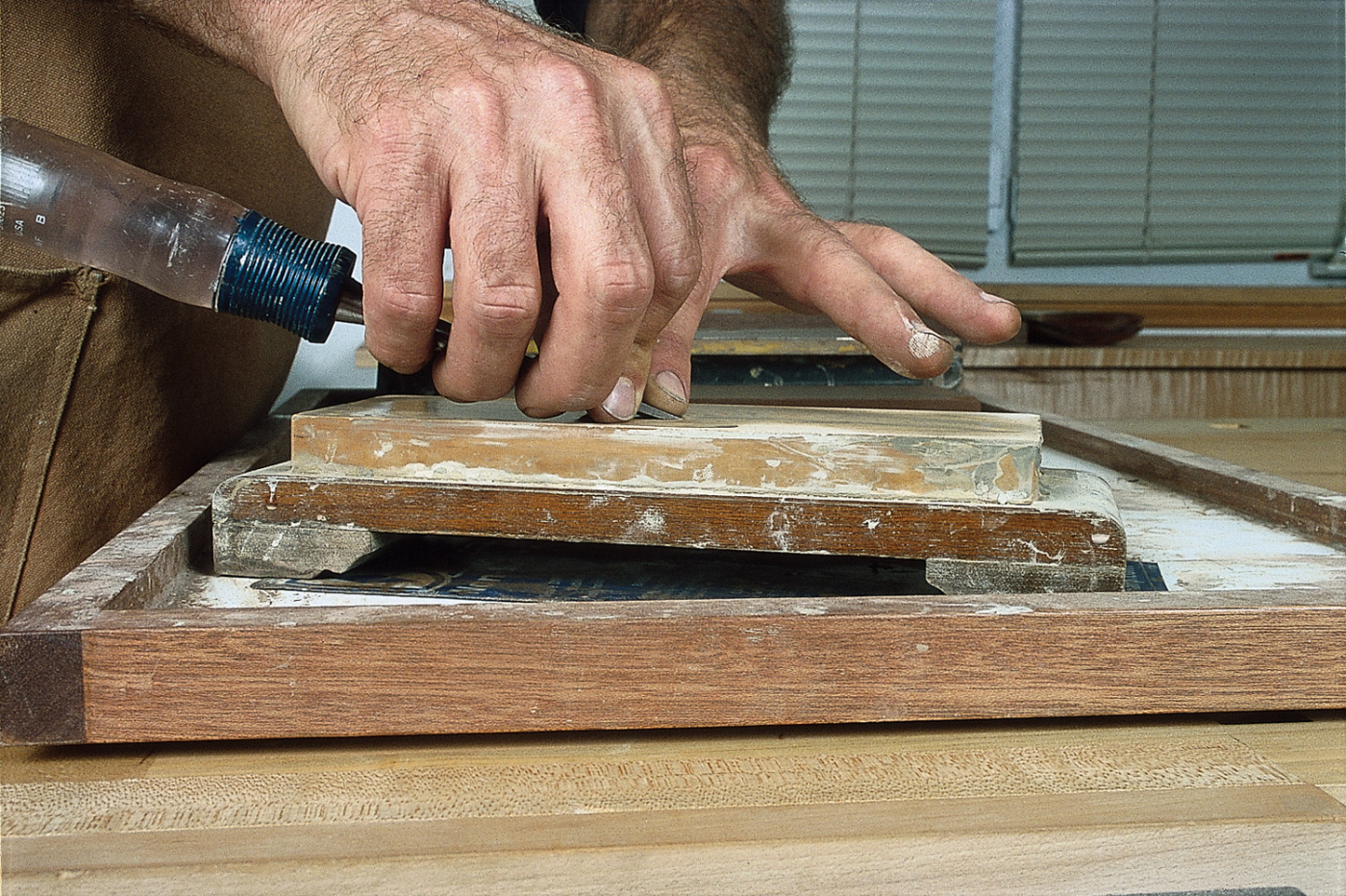 Side view: Curl the remaining fingers under the blade, applying just enough lift to keep the handle from falling (Lefties, simply reverse all these directions.)
Side view: Curl the remaining fingers under the blade, applying just enough lift to keep the handle from falling (Lefties, simply reverse all these directions.)
Here are some supplies and tools we find essential in our everyday work around the shop. We may receive a commission from sales referred by our links; however, we have carefully selected these products for their usefulness and quality.



 Old chisels can be brought back to life using these simple steps.
Old chisels can be brought back to life using these simple steps.




